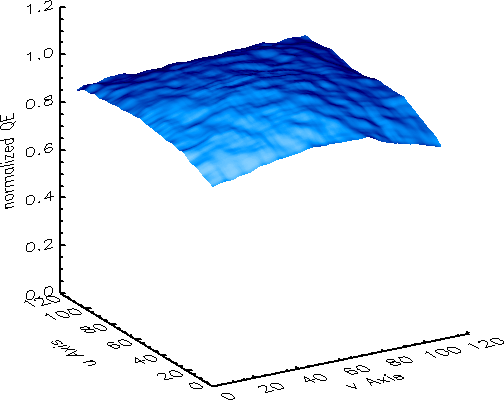


|

|
The HRC-I underwent flat field testing at the SAO MCP lab after XRCF testing. The data obtained has been analyzed by Charlie Wilton and Mike Juda, Their results can be found on Charlie's web page. They have shown that any deviations in the spatial characteristics of the efficiency are linear to first order. It is therefore appropriate to use the boxcar smoothed image for our analysis. The 128x128 fits image can be downloaded here (shift-clicking on the link will download the file). The surface plot is shown below.

To compare the offaxis data to the spatial model, we first must renormalize the model to the one dimensional quantum efficiency curve discussed in our on-axis analysis, at each energy of interest. Then, at each energy of interest, we perform a coordinate transformation on the image centroid to determine its location in (u,v) space. The coordinate transformation is given as:
|
= |
|
|
|
where (Z,Y) are given as (Zpixel,Ypixel) in block 128 coordinates. The rotation is a result of the (u,v) coordinates running along the edge of detector, while the (Z,Y) coordinates are along the long axes of the detector. This also results in a linear transformation of the Y axis by the 90.5 block 128 pixels.
For each energy, we simply compare the model efficiency versus the
calculated efficiency from the XRCF measurements. We are only
interested in the residuals (i.e.  xrcf -
xrcf -  model) for
each position. Also note that in some cases, the residuals may be
quite large. This is due to the fact that we are comparing our XRCF
results to the flight model. This lends further evidence to the fact
that the spatial characteristics of the detector qe have changed since
XRCF. No effort has been made to either renormalize the offaxis qe to
the flight settings, or compare the offaxis qe to a model of the
spatial characteristics of the XRCF qe. This analysis is only to show
that the off-center structure of the qe has changed quite
dramatically. One may verify this by subtracting the XRCF
flat field model from the Flight
flat field model.
model) for
each position. Also note that in some cases, the residuals may be
quite large. This is due to the fact that we are comparing our XRCF
results to the flight model. This lends further evidence to the fact
that the spatial characteristics of the detector qe have changed since
XRCF. No effort has been made to either renormalize the offaxis qe to
the flight settings, or compare the offaxis qe to a model of the
spatial characteristics of the XRCF qe. This analysis is only to show
that the off-center structure of the qe has changed quite
dramatically. One may verify this by subtracting the XRCF
flat field model from the Flight
flat field model.
The results are listed below, in order of energy.
Comments to CxcCal@cfa.harvard.edu
Last modified: 09/25/12
 |
The Chandra X-Ray
Center (CXC) is operated for NASA by the Smithsonian Astrophysical Observatory. 60 Garden Street, Cambridge, MA 02138 USA. Email: cxcweb@head.cfa.harvard.edu Smithsonian Institution, Copyright © 1998-2004. All rights reserved. |